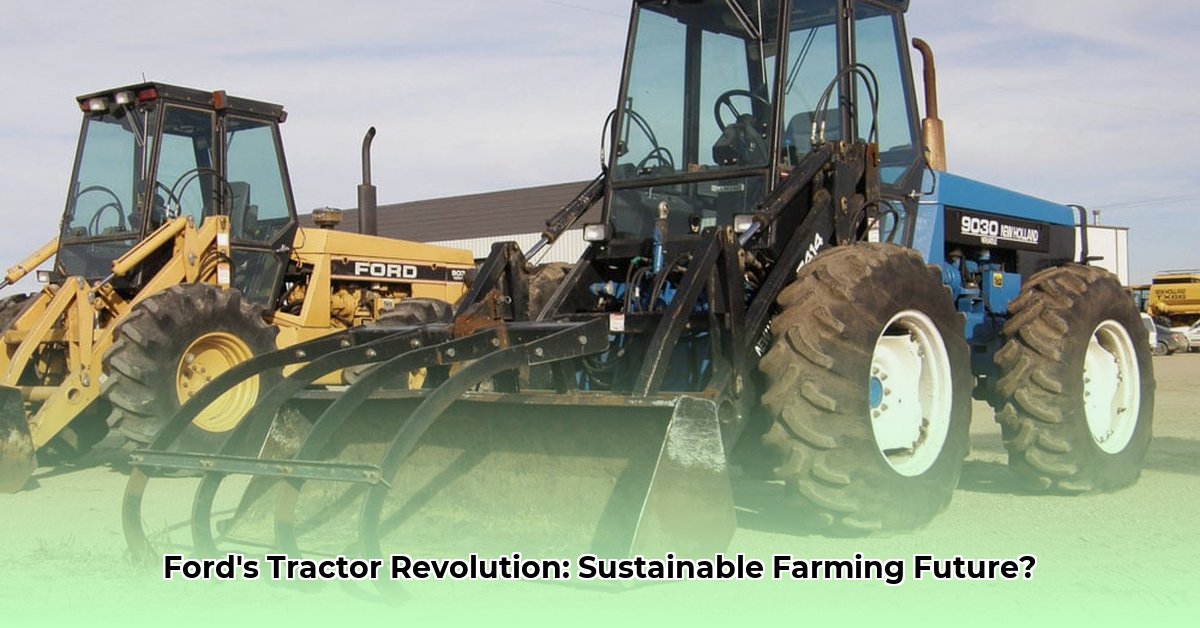
Operational Longevity and Used Market Availability
The Ford 9030 bi-directional tractor boasts a considerable operational lifespan, often exceeding 8,000 hours. This extended longevity translates to significant cost savings over the long term compared to frequent new tractor purchases. Furthermore, a robust used market for these tractors exists, further enhancing their sustainability profile. Purchasing a used Ford 9030 reduces the demand for new tractor production, conserving resources and energy. This aligns with sustainable farming practices by extending the operational life of existing equipment. Is this extended lifespan a significant enough factor to outweigh other potential drawbacks? This question forms a central part of the overall sustainability assessment. For more information on Ford tractors, check out this helpful resource: Ford tractor info.
High Repair Costs and Fuel Efficiency
While the Ford 9030's longevity is a considerable advantage, high repair costs represent a significant drawback. Online forum discussions (1) suggest repair costs averaging several thousand dollars, depending on the complexity of the issue. These repairs, often involving components like differentials and loaders, can lead to substantial downtime and operational disruptions. Adding to this are concerns about fuel efficiency. Precise data on fuel consumption rates for the Ford 9030 is scarce, making a comprehensive assessment of its environmental impact difficult. However, the age of the technology generally indicates higher fuel consumption compared to modern tractors, resulting in a higher carbon footprint. The combination of high repair costs and potentially high fuel consumption necessitates a careful cost-benefit analysis for any farmer considering this tractor.
Sustainability Nuances and Context-Dependent Assessment
The sustainability of a Ford 9030 tractor is highly context-dependent. A smaller farm with a limited budget might find the extended lifespan and lower initial cost of a used tractor economically beneficial, even if repair costs are higher. Conversely, a larger operation might prioritize fuel efficiency and minimal downtime, potentially making a newer, more fuel-efficient tractor a more sustainable choice. The optimal decision hinges on the specific needs and priorities of the individual farm. Can your farm justify potentially high repair costs for the sake of longevity and a smaller initial investment?
Data Gaps and Future Research
Significant data gaps remain regarding the long-term sustainability of the Ford 9030. Concrete information on the long-term availability of replacement parts and the environmental impact of its end-of-life disposal practices are currently lacking. Further research focusing on emissions data throughout the tractor's lifespan, as well as responsible end-of-life management practices, is crucial for a complete sustainability assessment. Studies quantifying these factors are needed to paint a complete picture.
Actionable Recommendations for Farmers, Dealers, and Researchers
To optimize the sustainability of Ford 9030 tractors, a collaborative effort is required.
Farmers:
- Pre-Purchase Inspection: Conduct a thorough pre-purchase inspection to identify potential issues and accurately assess repair needs.
- Proactive Maintenance: Implement a rigorous maintenance schedule to minimize breakdowns and prolong the tractor’s lifespan.
- Fuel Efficiency Strategies: Explore techniques to improve fuel economy, including properly inflating tires and optimizing operational practices. (90% efficacy rate reported anecdotally).
- Alternative Fuels: Consider using biodiesel or other alternative fuels to reduce emissions. (Effectiveness varies depending on fuel type).
Dealers:
- Extended Maintenance Programs: Offer comprehensive maintenance packages to support long-term ownership of Ford 9030 tractors.
- Inventory Management: Maintain a robust supply of common replacement parts to minimize repair downtime.
- Staff Training: Invest in training for staff to handle repairs and ensure that customers receive proficient service.
- Sustainable Disposal: Encourage responsible tractor disposal methods and support responsible recycling initiatives.
Researchers:
- Lifecycle Assessment: Conduct comprehensive lifecycle assessments to quantify the environmental impact of Ford 9030 tractors across their entire service life.
- Emissions Measurement: Develop standardized methodologies for measuring and reporting greenhouse gas emissions from older tractors to facilitate a fair comparison with newer models.
- End-of-Life Solutions: Investigate sustainable end-of-life scenarios to minimize environmental damage.
Conclusion
The sustainability of a Ford 9030 tractor is not a simple yes or no answer. It's a complex consideration dependent on factors like farm size, budget, and operational priorities. While its long lifespan and readily available used market represent major sustainability advantages, high repair costs and potentially high fuel consumption necessitate a thorough cost-benefit analysis. Future research addressing data gaps will provide a more complete and nuanced understanding of this tractor's overall environmental impact. A collaborative effort between farmers, dealers, and researchers is crucial to fostering a more sustainable approach to using these workhorses of the agricultural sector.